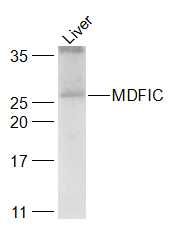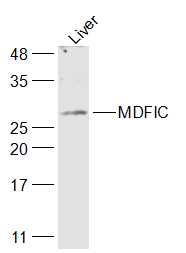MDFIC Polyclonal Antibody
Purified Rabbit Polyclonal Antibody (Pab)
- SPECIFICATION
- CITATIONS
- PROTOCOLS
- BACKGROUND

Application
| WB, IHC-P, IHC-F, IF, E |
|---|---|
| Primary Accession | Q9P1T7 |
| Reactivity | Rat, Pig, Dog, Bovine |
| Host | Rabbit |
| Clonality | Polyclonal |
| Calculated MW | 26 KDa |
| Physical State | Liquid |
| Immunogen | KLH conjugated synthetic peptide derived from human MDFIC |
| Epitope Specificity | 121-220/246 |
| Isotype | IgG |
| Purity | affinity purified by Protein A |
| Buffer | 0.01M TBS (pH7.4) with 1% BSA, 0.02% Proclin300 and 50% Glycerol. |
| SUBCELLULAR LOCATION | Isoform 1: Nucleus, nucleolus. Note=Also shows a granular distribution in the cytoplasm. Isoform 2: Cytoplasm. Note=Weak expression in the nucleus. |
| SIMILARITY | Belongs to the MDFI family. |
| SUBUNIT | Interacts with HAND1; leading to sequester HAND1 into the nucleolus and prevent its activity. Interacts with ZIC2 (By similarity). The C-terminus interacts with HIV-1 Tat and Rev, AXIN1, the histidine-rich region of CCNT1/cyclin-T and weakly with LEF1. |
| Important Note | This product as supplied is intended for research use only, not for use in human, therapeutic or diagnostic applications. |
| Background Descriptions | This gene product is a member of a family of proteins characterized by a specific cysteine-rich C-terminal domain, which is involved in transcriptional regulation of viral genome expression. Alternative translation initiation from an upstream non-AUG (GUG), and an in-frame, downstream AUG codon, results in the production of two isoforms, p40 and p32, respectively, which have different subcellular localization; p32 is mainly found in the cytoplasm, whereas p40 is targeted to the nucleolus. Both isoforms have transcriptional regulatory activity that is attributable to the cysteine-rich C-terminal domain. Alternative splicing results in multiple transcript variants. |
| Gene ID | 29969 |
|---|---|
| Other Names | MyoD family inhibitor domain-containing protein, I-mfa domain-containing protein, hIC, MDFIC (HGNC:28870) |
| Target/Specificity | Expressed in lymphoid organs (spleen, thymus, peripheral blood leukocytes) as well as prostate, uterus and small intestine. |
| Dilution | WB=1:500-2000,IHC-P=1:100-500,IHC-F=1:100-500,IF=1:100-500,ELISA=1:5000-10000 |
| Storage | Store at -20 ℃ for one year. Avoid repeated freeze/thaw cycles. When reconstituted in sterile pH 7.4 0.01M PBS or diluent of antibody the antibody is stable for at least two weeks at 2-4 ℃. |
| Name | MDFIC (HGNC:28870) |
|---|---|
| Function | Required to control the activity of various transcription factors through their sequestration in the cytoplasm. Retains nuclear Zic proteins ZIC1, ZIC2 and ZIC3 in the cytoplasm and inhibits their transcriptional activation (By similarity). Modulates the expression from cellular promoters. Binds to the axin complex, resulting in an increase in the level of free beta-catenin (PubMed:12192039). Affects axin regulation of the WNT and JNK signaling pathways (PubMed:12192039). Involved in the development of lymphatic vessel valves (By similarity). Required to promote lymphatic endothelial cell migration, in a process that involves down-regulation of integrin beta 1 activation and control of cell adhesion to the extracellular matrix (PubMed:35235341). Regulates the activity of mechanosensitive Piezo channel (PubMed:37590348). |
| Cellular Location | [Isoform 1]: Nucleus, nucleolus. Note=Also shows a granular distribution in the cytoplasm |
| Tissue Location | Expressed in lymphatic tissues. Detected in the spleen, thymus, peripheral blood leukocytes as well as prostate, uterus and small intestine. Expressed in lymphatic endothelial cells (PubMed:35235341). |

Thousands of laboratories across the world have published research that depended on the performance of antibodies from Abcepta to advance their research. Check out links to articles that cite our products in major peer-reviewed journals, organized by research category.
info@abcepta.com, and receive a free "I Love Antibodies" mug.
Provided below are standard protocols that you may find useful for product applications.
If you have used an Abcepta product and would like to share how it has performed, please click on the "Submit Review" button and provide the requested information. Our staff will examine and post your review and contact you if needed.
If you have any additional inquiries please email technical services at tech@abcepta.com.













 Foundational characteristics of cancer include proliferation, angiogenesis, migration, evasion of apoptosis, and cellular immortality. Find key markers for these cellular processes and antibodies to detect them.
Foundational characteristics of cancer include proliferation, angiogenesis, migration, evasion of apoptosis, and cellular immortality. Find key markers for these cellular processes and antibodies to detect them. The SUMOplot™ Analysis Program predicts and scores sumoylation sites in your protein. SUMOylation is a post-translational modification involved in various cellular processes, such as nuclear-cytosolic transport, transcriptional regulation, apoptosis, protein stability, response to stress, and progression through the cell cycle.
The SUMOplot™ Analysis Program predicts and scores sumoylation sites in your protein. SUMOylation is a post-translational modification involved in various cellular processes, such as nuclear-cytosolic transport, transcriptional regulation, apoptosis, protein stability, response to stress, and progression through the cell cycle. The Autophagy Receptor Motif Plotter predicts and scores autophagy receptor binding sites in your protein. Identifying proteins connected to this pathway is critical to understanding the role of autophagy in physiological as well as pathological processes such as development, differentiation, neurodegenerative diseases, stress, infection, and cancer.
The Autophagy Receptor Motif Plotter predicts and scores autophagy receptor binding sites in your protein. Identifying proteins connected to this pathway is critical to understanding the role of autophagy in physiological as well as pathological processes such as development, differentiation, neurodegenerative diseases, stress, infection, and cancer.



